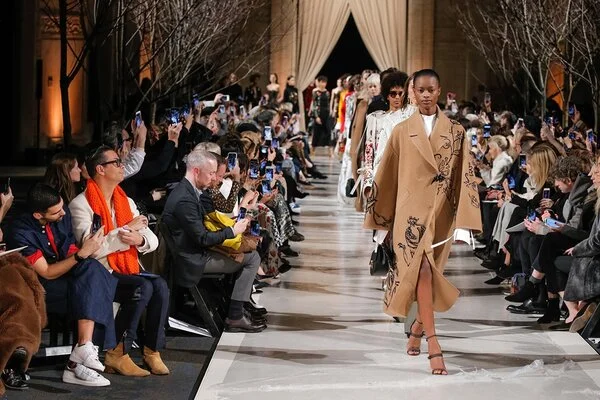London Fashion Week 2023: Where Art Meets Style

Independent designers have brought their unique style and creativity to fashion, while still considering the needs and preferences of their customers.
Moralıoğlu
This season, designer Moralıoğlu found inspiration in the late Duchess of Devonshire, Deborah Mitford, and Chatsworth House in Derbyshire. The collection featured a Barbour collaboration: a waxed cotton trapeze opera coat with a quilted liner adorned in velvet rose devoré jacquard, accented by genuine Chatsworth chintz curtain remnants. The collection charmed with 1950s-inspired car coats, peplum dresses, lingerie slips, and wool cardigans, skillfully blending opulence and resourceful craftsmanship.

Moralıoğlu’s show resonated with prevalent themes of the week, such as 1950s silhouettes and intricate lingerie detailing. The collection embraced sustainability, with Phoebe English using surplus bridal fabric and Ahluwalia incorporating at least 60% recycled materials into checkered denim. In summary, many collections this season leaned towards greater wearability while retaining the distinctiveness that characterizes independent labels. Having a boutique can help designers understand customer desires.
Emilia Wickstead
Emilia Wickstead acknowledged the significant role played by her flagship store on Sloane Street as an educational experience for her. During this season, she noticed a shift in customer preferences towards something more relaxed and gentle. Her collection featured simplified silhouettes with an elegant twist, drawing inspiration from the ambiance of the French Riviera in the 1930s.

The designs incorporated deckchair stripes, adorning a range of garments including coats, mini dresses, and column gowns. Additionally, the 1930s influence was evident in the collection with the introduction of wide, tailored trousers and a denim sailor top. Wickstead’s ability to transform smart dressing into something effortless was exemplified by long tunic dresses in shades of pear green and shimmering silvery sequins.
Roksanda Ilinčić
Roksanda Ilinčić, the Serbian-born designer, showcased a collection at the Barbican, set within the austere backdrop of its circular courtyard. The gowns in her collection exuded a captivating simplicity, drawing inspiration from Serbia’s historic monasteries. This influence was most notably reflected in the wimple-like headwear worn by the initial models.

The collection featured gently oversized tailoring crafted from concrete-colored wool silk mélange, evoking a sense of understated elegance. Monastic robes were reimagined as a strapless grey dress adorned with origami folds and lime-green fil coupé fringes. For evening attire, Ilinčić introduced white silk kaftans adorned with yellow and pink watercolor brush patterns.
Ilinčić remarked, “Judging by the preferences of my customers at my Mount Street store, there is a growing desire for more exciting and distinctive fashion. It seems to be a post-Covid longing to elevate one’s style to the next level. I offer both serene luxury in my tailoring and opulent eveningwear. My customers seek the extremes, craving both quiet sophistication and lavish extravagance, with no desire for middle-ground options.”
Simone Rocha
Simone Rocha’s evocative presentation this season introduced a unique blend of creativity while incorporating more practical and approachable silhouettes compared to previous collections. Notably, her collaboration with Crocs yielded a highly marketable line featuring pearl- and crystal-embellished footwear.

Incorporating a touch of sportswear influence, the collection featured elements such as a cropped parka adorned with 3D fabric roses. Rocha drew inspiration from artist Cy Twombly’s cake sculptures, evident in the swagged icing motif applied as embellishments on cotton shirts and tulle dresses. Adding a delightful touch, a pearlescent bag shaped like a miniature cake stood out as a charming accessory.
Richard Quinn
Richard Quinn’s collection was a celebration of romance and florals, featuring dresses and evening coats reminiscent of 1950s couture. These garments were adorned with intricate beadwork, sequins, and embroidered blossoms, adding a touch of timeless elegance to the pieces. Meanwhile, Molly Goddard’s collection drew inspiration from the femininity of the 1950s, showcasing tulle skirts in buttermilk and apricot, complemented by bra tops and neatly tailored cardigans.

In the diverse landscape of London fashion, there is seldom a unanimous stylistic direction. A contrasting vibe emerged from musician Skepta, who relaunched his sportswear label Mains with a catwalk show in collaboration with Puma. The show combined elements of preppy 1970s tennis club aesthetics with edgy motorcycle leathers, reflecting a distinct and eclectic style.
Jonathan Anderson
In his latest show, Jonathan Anderson explored form and texture, beginning with models wearing clay interpretations of jackets and shorts. The collection featured creative takes on functional daywear, including combats, bomber jackets, leather vests, and jackets.

For evening, Anderson introduced ruched jersey dresses in pale blue and sage, cleverly wrapped to reveal the midriff. The collection also included captivating basketwork mini dresses and a crystal-unraveled pencil skirt, highlighting Anderson’s innovative fashion approach.

- Art
- Causes
- Best Offers
- Crafts
- Dance
- Drinks
- Film
- Fitness
- Food
- Игры
- Festival
- Gardening
- Health
- Главная
- Literature
- Music
- Networking
- Другое
- Party
- Religion
- Shopping
- Sports
- Theater
- Wellness



